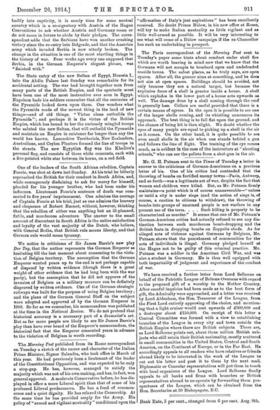The Paris correspondent of the Morning Post sent to Tuesday's
paper some hints about conduct under shell fire which are worth bearing in mind now that we know that the Germans will not scruple to bombard open and undefended seaside towns. The safest places, as he truly says, are open spaces. After all, the gunner aims at something, and he does not aim at open spaces. Buildings should be avoided, not only because they are a natural target, but because the explosive force of a shell is greater inside a house. A shell which explodes in the lower part of a house acts upwards as well. The damage done by a shell coming through the roof is generally less. Cellars are useful provided that there is a certain means of egress. In the open it is possible to see one of the larger shells coming, and its whistling announces its approach. The best thing is to fall flat upon the ground, and the chance of being hit is then slight. We doubt whether the eyes of many people are equal to picking up a shell in the air as it comes. On the other hand, it is quite possible to see even small shells in the air when one stands behind a gun and follows the line of flight. The training of the eye means much, as is evident in the case of the instructors at "shooting schools," who can see the pellets from a shot-gun in the air.


































 Previous page
Previous page